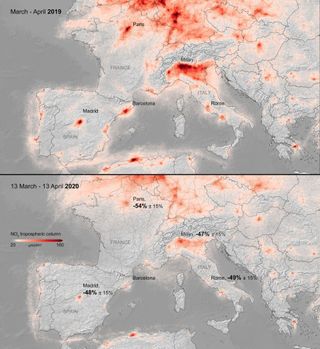Europe's air pollution drop continues amid coronavirus closures

As a new coronavirus continues to cause serious respiratory disease around the globe, countries have enacted strong measures to curtail the pandemic's spread — and the effects on emissions remain visible from space.
The European Space Agency's (ESA) Copernicus network monitors compounds in the atmosphere that are important in understanding climate and human health. Among those compounds is nitrogen dioxide. According to recent analyses of Copernicus data, a side effect of coronavirus shutdown measures is the slashing of nitrogen dioxide emissions, with some countries even cutting them in half.
The huge cuts are particularly visible in a new pair of maps that compares baseline data, gathered in March and April 2019, with new data collected between mid-March and mid-April 2020. By the time that latter period began, many European countries were requesting or requiring residents to stay at home as much as possible to reduce the disease's spread.
Related: Coronavirus pandemic and spaceflight: Complete coverage
More: Coronavirus prevention measures take their toll on astronomy
According to those maps, the result is a stunning decrease in atmospheric nitrogen dioxide over urban areas. Paris levels are down nearly 55%, with Rome, Milan and Madrid all approaching 50% reductions compared to normal. (Those values are accurate to within 15%, according to a statement from ESA about the observations.)
The observed decreases in nitrogen dioxide cannot necessarily be chalked up entirely to coronavirus-mitigation measures, since the prevalence of the chemical also varies daily with the weather. But the compound is produced by cars and trucks, power plants and factories, which could all be impacted by the coronavirus containment measures.
ESA is still working on similar analyses for more northern cities, where nitrogen dioxide levels vary more dramatically with the weather, according to the statement.
Get the Space.com Newsletter
Breaking space news, the latest updates on rocket launches, skywatching events and more!
Worldwide, the coronavirus-spread disease COVID-19 has infected more than 2 million people, according to data compiled by the Johns Hopkins University.
- NASA satellite sees air pollution drop over northeastern US amid coronavirus outbreak
- Watching coronavirus outbreak from space a 'surreal' experience, astronauts say
- 'Going back to a different planet': Astronauts will return to Earth soon amid the coronavirus pandemic
Email Meghan Bartels at mbartels@space.com or follow her @meghanbartels. Follow us on Twitter @Spacedotcom and on Facebook.
OFFER: Save 45% on 'All About Space' 'How it Works' and 'All About History'!
For a limited time, you can take out a digital subscription to any of our best-selling science magazines for just $2.38 per month, or 45% off the standard price for the first three months.
Join our Space Forums to keep talking space on the latest missions, night sky and more! And if you have a news tip, correction or comment, let us know at: community@space.com.

Meghan is a senior writer at Space.com and has more than five years' experience as a science journalist based in New York City. She joined Space.com in July 2018, with previous writing published in outlets including Newsweek and Audubon. Meghan earned an MA in science journalism from New York University and a BA in classics from Georgetown University, and in her free time she enjoys reading and visiting museums. Follow her on Twitter at @meghanbartels.

